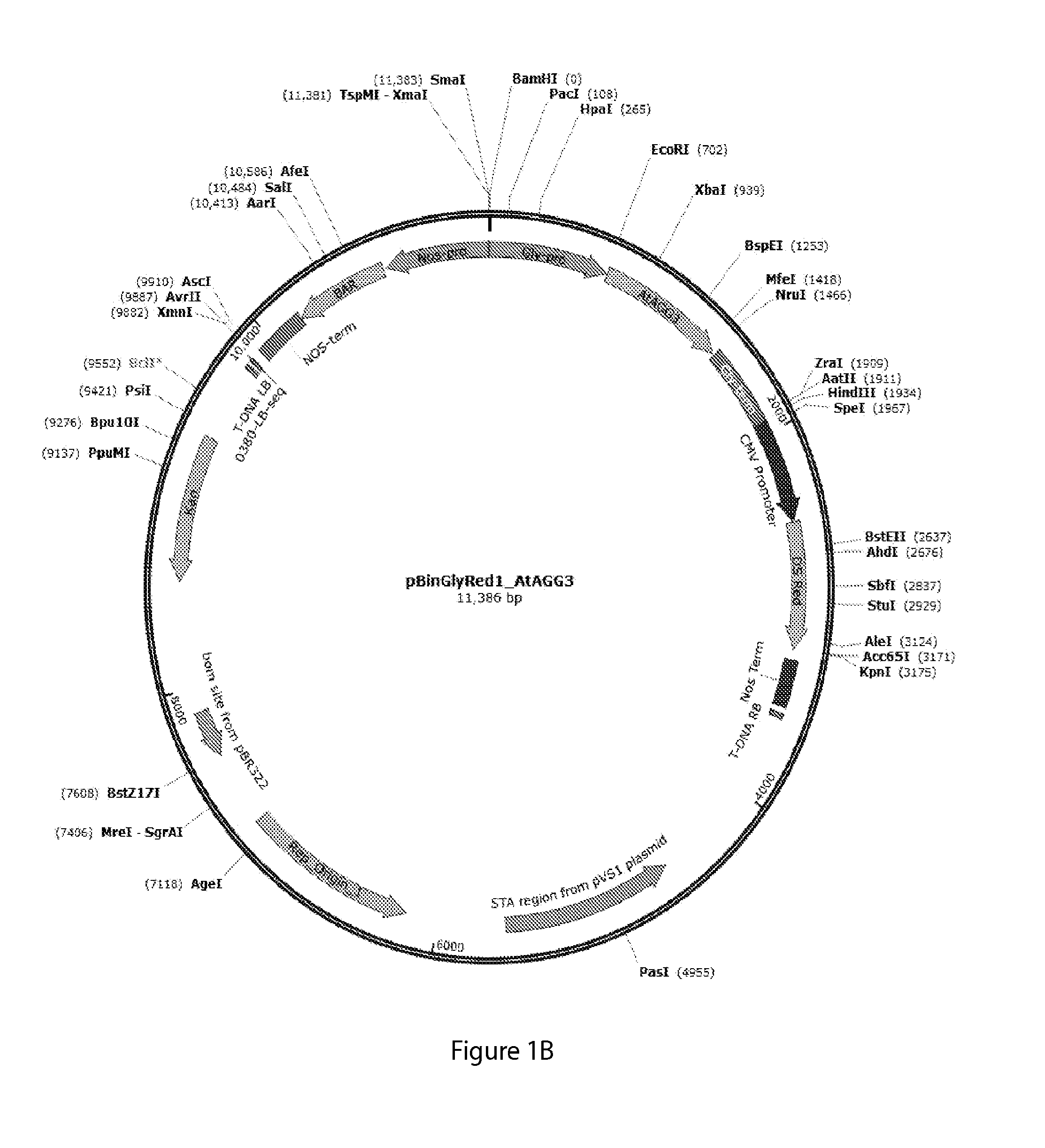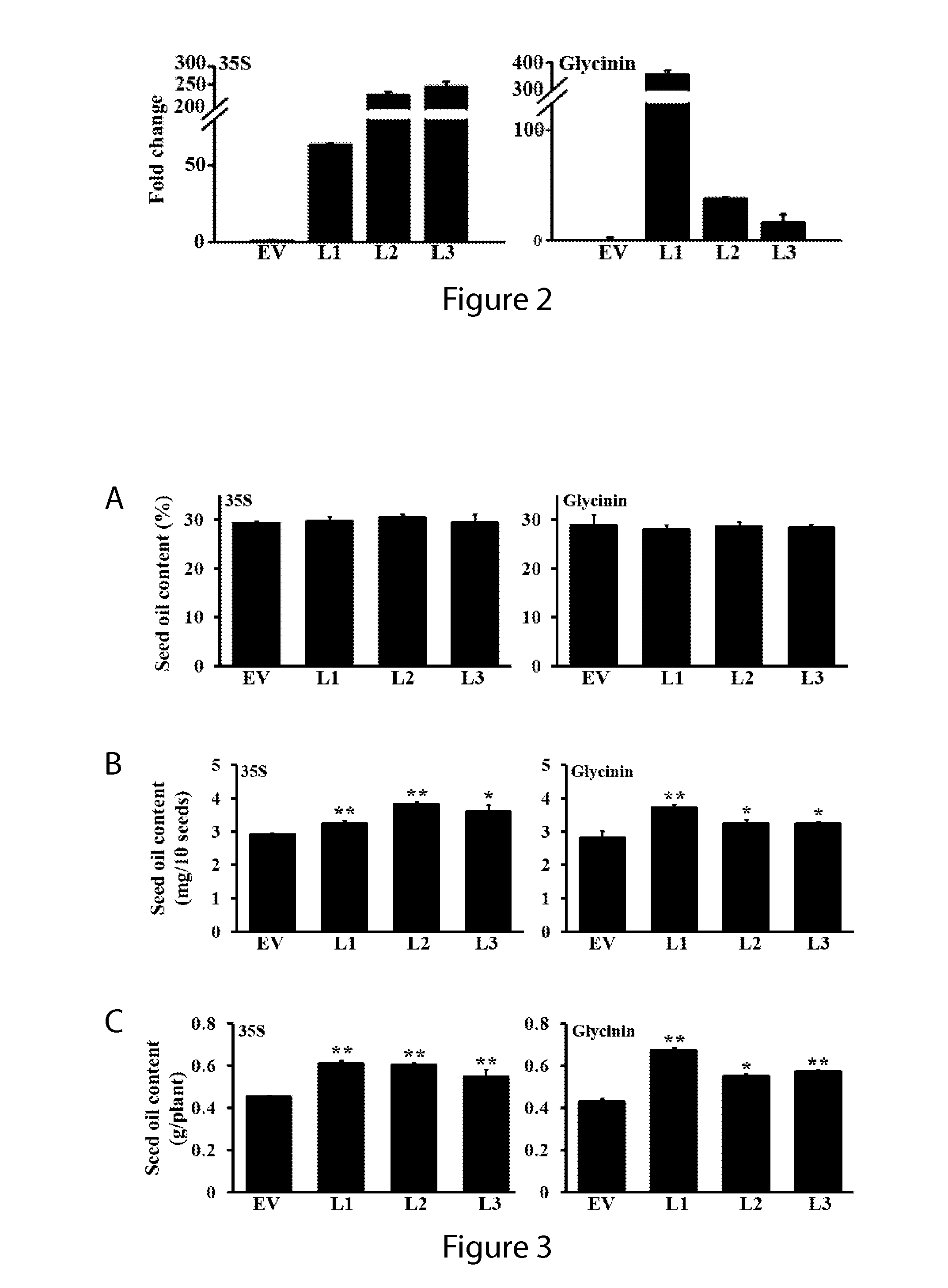Enhanced Oil Production And Stress Tolerance In Plants
a technology of stress tolerance and plant oil, applied in the field of plant molecular biology, can solve the problems of significant unmet need to develop plants, insufficient supply of plant oils, and inability to meet the needs of seed and fruit production,
- Summary
- Abstract
- Description
- Claims
- Application Information
AI Technical Summary
Benefits of technology
Problems solved by technology
Method used
Image
Examples
example 1
Generation of Constructs for Overexpressing Arabidopsis AGG3 in Camelina
[0198]To evaluate the role of Arabidopsis thaliana AGG3 in conferring increased stress resistance, biomass production, and higher seed yield, transgenic Camelina (Camelina sativa, variety Suneson) plants were generated using two types of constructs: CaMV35S:AGG3, expressing Arabidopsis thaliana AGG3 cDNA (SEQ ID NO:1) with a constitutive CaMV35S promoter (FIG. 1A), and Glycinin:AGG3, expressing Arabidopsis thaliana AGG3 cDNA (SEQ ID NO:1) with a seed-specific, strong soybean glycinin promoter (FIG. 1B). The constructs also included a DsRed reporter gene for visual selection of transgenic seeds, and a Bar gene for Basta® resistance in transgenic plants (e.g., a nucleotide sequence encoding a phosphinothricin acetyltransferase enzyme which upon expression confers resistance to the herbicide glufosinate-ammonium “Basta®).
[0199]For Camelina transformation, full-length Arabidopsis thaliana AGG3 cDNA (SEQ ID NO:1) wa...
example 2
Generation of Transgenic Camelina Plants Overexpressing Arabidopsis AGG3
[0200]As Camelina sativa is being developed as a model for herbaceous bioenergy crops and genetic improvement of biomass yield as a major target trait, in addition to higher oil production (Ghamkhar et al., 2010; Nguyen et al., 2013), it was selected as a model system for the experiments described herein.
[0201]Six-week old wild-type Camelina plants were transformed with CaMV35S:AGG3, Glycinin:AGG3, and empty vectors using floral dip (Lu and Kang, 2008) followed by a second round of transformation after two weeks to improve the transformation efficiency. Transgenic seeds (T1) were visually selected by Ds-Red expression and transferred to soil for growth to maturity. Seeds from lines displaying a 3:1 segregation of T2 transgenic seeds on the basis of Ds-Red signal were isolated, selfed, and grown to homozygosity. Homozygous T3 seeds of the transgenic plants were selected, and three independent transgenic lines exh...
example 3
Overexpression of AGG3 in Camelina Results in Higher Seed Oil Content on Per Plant Basis
[0205]Improvement of seed yield and oil content are the key targets for the biotechnological modification of oilseed crops. Mutations in the AGG3 homologs in rice result in changes in seed size, seed length, and panicle branching (Fan et al., 2009; Huang et al., 2009; Mao et al., 2010). Similarly, changes in expression of the AGG3 gene in Arabidopsis by T-DNA knockout or overexpression leads to altered flower and seed sizes (Chakravorty et al., 2011; Li et al., 2012). However, whether such changes in seed size have any effect on the overall seed composition, seed viability, or carbon partitioning has not been evaluated to date. This example was designed to investigate the effect of AGG3 overexpression in the oilseed crop Camelina.
[0206]Transgenic seeds obtained from transgenic plants prepared as described above in Example 2 were evaluated for their oil quantity per seed, per plant, and for oil c...
PUM
| Property | Measurement | Unit |
|---|---|---|
| Fraction | aaaaa | aaaaa |
| Fraction | aaaaa | aaaaa |
| Fraction | aaaaa | aaaaa |
Abstract
Description
Claims
Application Information
 Login to View More
Login to View More - R&D
- Intellectual Property
- Life Sciences
- Materials
- Tech Scout
- Unparalleled Data Quality
- Higher Quality Content
- 60% Fewer Hallucinations
Browse by: Latest US Patents, China's latest patents, Technical Efficacy Thesaurus, Application Domain, Technology Topic, Popular Technical Reports.
© 2025 PatSnap. All rights reserved.Legal|Privacy policy|Modern Slavery Act Transparency Statement|Sitemap|About US| Contact US: help@patsnap.com



